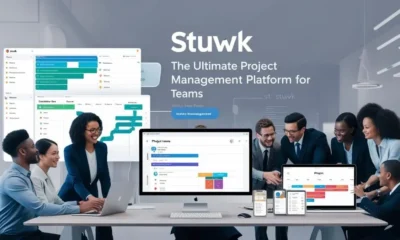AI
How AI Deinterlacing is Transforming Video Restoration
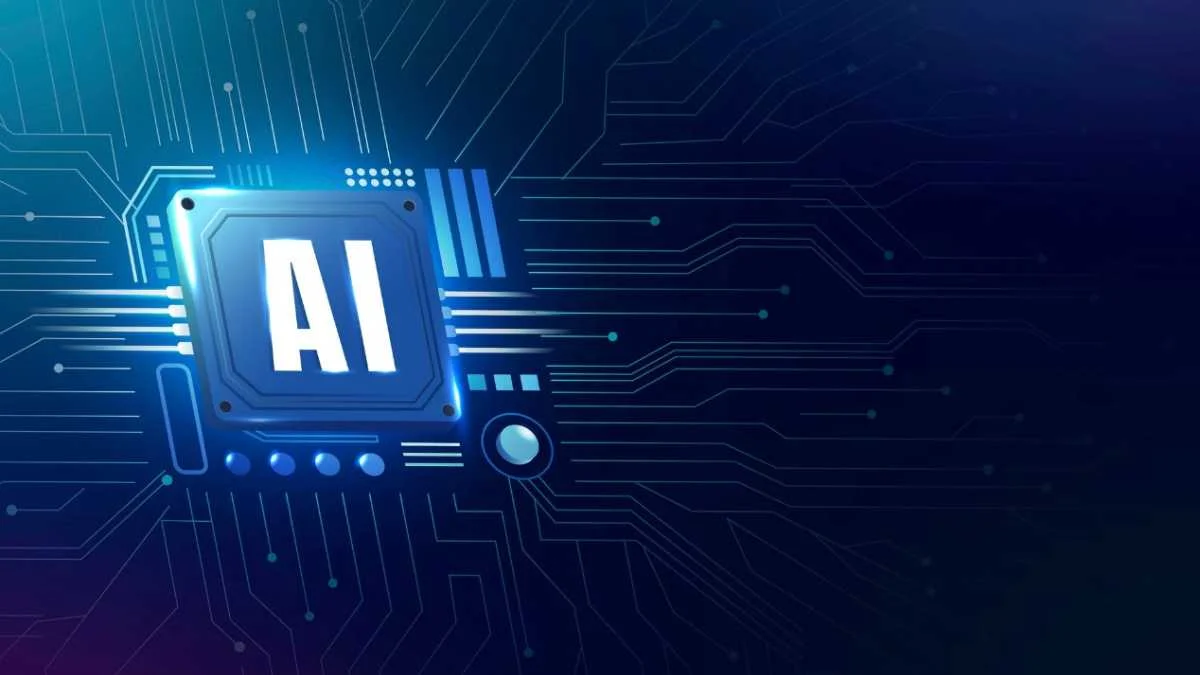
In the digital age, video quality plays a critical role in delivering an immersive and enjoyable viewing experience. However, many older videos suffer from interlacing issues, which result in visible horizontal lines, motion blur, and flickering. These distortions can make vintage footage, old TV broadcasts, and archival materials difficult to watch on modern high-definition screens.
Thankfully, advancements in artificial intelligence (AI) have introduced AI deinterlacing, a powerful technology that enhances video clarity by intelligently reconstructing frames. With AI-powered tools like UniFab, users can effectively deinterlace videos while preserving fine details, smooth motion, and overall image quality.
Understanding Interlacing and Its Challenges
Interlacing was a widely used technique in early television broadcasting. It was introduced as a way to optimize bandwidth while improving motion perception on CRT televisions. Instead of displaying full frames at once, interlaced videos divide each frame into two alternating fields—one consisting of odd-numbered lines and the other of even-numbered lines.
This approach worked well for older television screens, but it presents several issues when viewed on modern digital displays. Some of the most common problems include:
- Horizontal lines – Distinct lines appear across moving objects, making motion look unnatural.
- Flickering and blurring – Interlaced video often causes a jittery effect, particularly in fast-moving scenes.
- Loss of sharpness – The lack of a full-frame display results in reduced detail and clarity.
To resolve these issues, deinterlacing is necessary. Traditional deinterlacing methods, however, often lead to quality degradation by blending frames, which may introduce motion artifacts or blur fine details. This is where AI-powered deinterlacing becomes a game-changer.
How AI Deinterlacing Works
Unlike conventional deinterlacing methods, AI deinterlacing utilizes deep learning models to reconstruct missing details intelligently. Instead of merely blending or removing interlaced fields, AI analyzes video patterns, motion, and object edges to create a high-quality progressive scan version of the footage.
Some of the key benefits of AI-driven deinterlacing include:
✅ Sharper details – AI enhances edges and textures without causing blurring.
✅ Smooth motion – Reduces flickering and ensures fluid video playback.
✅ Minimal artifacts – Preserves the original visual integrity while eliminating interlacing distortions.
With AI-powered tools like UniFab, users can restore old or interlaced footage effortlessly, making it suitable for high-definition displays, streaming services, and modern viewing platforms.
Why Deinterlacing Matters

The need to deinterlace video is crucial across various industries and applications:
- Film Restoration – Old movies and documentaries can be upgraded to match today’s high-definition standards.
- TV Archives – Classic television shows and broadcasts can be prepared for digital streaming without quality loss.
- Historical Preservation – Museums and archivists can restore rare video footage for long-term digital storage.
- Content Creators – Video editors can modernize old interlaced footage and repurpose it for current digital platforms.
As the demand for high-resolution content continues to grow, AI-powered deinterlacing ensures that older videos remain visually appealing and relevant in today’s digital landscape.
AI Deinterlacing vs. Traditional Methods
Traditional deinterlacing methods, such as frame blending, line doubling, or motion compensation, often lead to quality loss. These methods either introduce motion blur or fail to accurately reconstruct missing details. AI-based deinterlace solutions, on the other hand, intelligently analyze frame structures to generate crisp, high-resolution outputs without compromising image integrity.
A Quick Comparison:
| Feature | Traditional Deinterlacing | AI Deinterlacing |
| Sharpness | Reduced clarity | Enhanced details |
| Motion Smoothness | Blurring & ghosting | Natural motion |
| Processing Quality | Loss of details | Intelligent frame reconstruction |
| Suitability for HD | Limited improvement | Optimal for modern displays |
The Future of Video Enhancement with AI
AI continues to redefine video restoration, making AI deinterlacing more effective and accessible than ever. As deep learning models improve, we can expect even more sophisticated tools that handle complex video distortions with minimal user input.
With AI advancements, video enhancement will go beyond just deinterlacing. Technologies such as AI video upscaling, AI frame interpolation, and AI noise reduction are becoming increasingly common, allowing users to improve the quality of any footage—whether it’s a decades-old home movie or a low-resolution clip from the internet.
Conclusion
For anyone looking to deinterlace and enhance their videos, AI-powered tools like UniFab provide a seamless solution. These tools not only restore old footage but also future-proof it for high-resolution displays, online streaming platforms, and professional video production.
With AI at the forefront of video enhancement, the past is no longer confined to outdated formats—it is being transformed for the future. Whether you’re an archivist, content creator, or filmmaker, AI deinterlacing ensures that every frame is seen in the best possible quality.
AI
Lillienu: AI-Powered Platform for Smarter Decision Making

Lillienu is the most advanced AI, ML, and cloud camping platform that brings digital structures to optimality. As designed to handle maximum traffic data to analyzing nature, it help businesses to come up with accurate quick decisions. Lillienu meets current trends and increasing demand for automation and intelligent systems targeted at non-car businesses by implementing advanced algorithms and technologies needed for large business organization with large customer base. It is mainly concentrated on deriving value from the software from the users’ perspective as well as improving collaborators’ efficiency while deploying decision making processes and proper functioning. Dealing with the customer or dealing with large shipments of data, it provides solutions that enhance performance, minimize expenses, and increase accuracy of decision-making.
Understanding AI-Powered Decision Making
AI integrated decision making refers to using artificial intelligence to make decisions through analysis, pattern recognition and defining subsequent course of action. This has a positive effect on the speed and accuracy of business decision making processes that enable organizations change strategy with speed in responding to changing market conditions. This is improved on by machine learning, a sub category of artificial intelligence since it allows a system to learn from the data it has been fed, make predictions and improve on its decision making process each time. Lillienu goes a step further by including cloud since the program will have to be scalable and accessible. It further integrates these technologies to enable dynamic and data driven decisions making across industries.
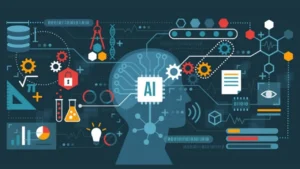
Applications of Lillienu in Various Industries
- Healthcare: Enhances diagnoses and treatment planning with advanced data analysis and AI-driven insights.
- Retail: Optimizes inventory management, demand forecasting, and customer personalization for improved sales strategies.
- Finance: Detects fraud, assesses risks, and enhances financial forecasting with accurate, data-driven tools.
- Manufacturing: Streamlines supply chains, improves production efficiency, and reduces waste through predictive analytics.
- Education: Personalizes e-learning experiences and improves institutional efficiency using AI-powered solutions.
Key Features of Lillienu
Lillienu offers a range of features that redefine digital optimization. Its advanced data processing capabilities allow organizations to handle massive datasets efficiently. Integration with existing systems ensures seamless adoption without disrupting current workflows. Real-time analytics provide insights that drive informed decisions, while automation streamlines processes, reducing manual effort. Additionally, its ability to personalize solutions makes it adaptable to various industries. By enhancing system performance through AI algorithms and leveraging cloud computing for storage and accessibility, it creates a robust platform for businesses. These features collectively make Lillienu an invaluable tool for enhancing decision-making, improving efficiency, and achieving sustainable growth.
How Lillienu Optimizes Digital Systems
Lillienu increases efficiency in the process by elimination of repetitive tasks in various digital systems. Using AI algorithms, the computer evaluates and processes data and immediately shows areas of problem and ways to fix them. Third, the cloud solutions that the platform is integrated with guarantee data storage and retrieval as well as scalability. For instance, a retail company might employ it to identify consumer’s behavior in buying patterns and manage the appropriate stock management, or possibly a health care entity may possibly improve the delivery of care through smart health status tracking. By automating routine processes and delivering insights, it improves overall system performance. It transforms digital operations, empowering organizations to focus on innovation and strategy rather than mundane tasks.
Benefits of Using Lillienu
- Increased Efficiency: Automates tasks and streamlines workflows to boost operational performance.
- Cost Reduction: Minimizes manual intervention and resource wastage, leading to significant cost savings.
- Enhanced Decision-Making: Provides accurate, data-driven insights to support informed business decisions.
- Improved User Experience: Personalizes services and delivers faster solutions for superior customer satisfaction.
- Scalability and Adaptability: Scales seamlessly with organizational growth, addressing evolving operational needs effectively.
Integration and Implementation of Lillienu
Integrating Lillienu into existing systems is seamless due to its compatibility with diverse digital platforms. The implementation process involves assessing organizational needs, customizing solutions, and deploying the platform with minimal disruption. Businesses can integrate Lillienu with CRM, ERP, and other enterprise systems to maximize efficiency. Customization options ensure that the platform aligns with unique business requirements. Once implemented, it starts analyzing workflows, identifying inefficiencies, and delivering actionable insights. Organizations also receive ongoing support for updates and system enhancements. This adaptability and ease of integration make it ideal choice for businesses looking to harness the power of AI, ML, and cloud computing.
Security and Reliability
Security and reliability is important for Lillienu. It also includes advanced encryption protocols in a way that all form of information which is sensitive cannot be accessed by anyone else apart from the user. The platform’s architectural design has also integrated AI to not only recognize but also prevent cyber threats in advance. Other tools regarding where data is backed up and recovered add to the reliability; protecting it from events that may occur. On this basis, it secures and provides relevant data storage based on cloud computing by allowing scalable access to the resources. These measures also help to pay attention to the regulations Regarding data protection and also gain the trust of the users.

Read Also: How to protect user data and user’s data privacy?
Future of AI and ML with Lillienu
Based on the current development and analysis, Lillienu is ready to spearhead the next generation of AI and ML adoption. Upcoming trends reveal enhanced promotion of intelligent technologies in the market. Through growth the company adapts to the development of technologies in the future, a factor making Lillienu relevant in future. The purpose of elaborating such platform has its desire on the automation process, scalability, and personalization, which corresponds to the increasing importance of intelligent systems. Some furtherance can be made on the use of more accurate forecasting or the gadgets, or real-time communication applications.
Conclusion
Lillienu is a relatively unseen advancement in the current age making use of artificial intelligence in decision making and digitization. When applied together as AI, ML, and cloud computing merge, it enables the business to make better decisions quicker and more accurately. It is a high value tool across industries due to it flexibility, productivity and adaptability that fosters innovation and efficiency. Used for improving the overall user experience to managing work processes, it changes the way that organizations prevail in the new world.. As businesses continue to embrace AI-driven solutions, it stands out as a pioneering platform that combines cutting-edge technology with practical applications. Embracing it means investing in the future of smarter, data-driven decision-making.
AI
Parallel Artificial Intelligence: Revolutionizing Speed, Efficiency, and Scalability in AI Systems
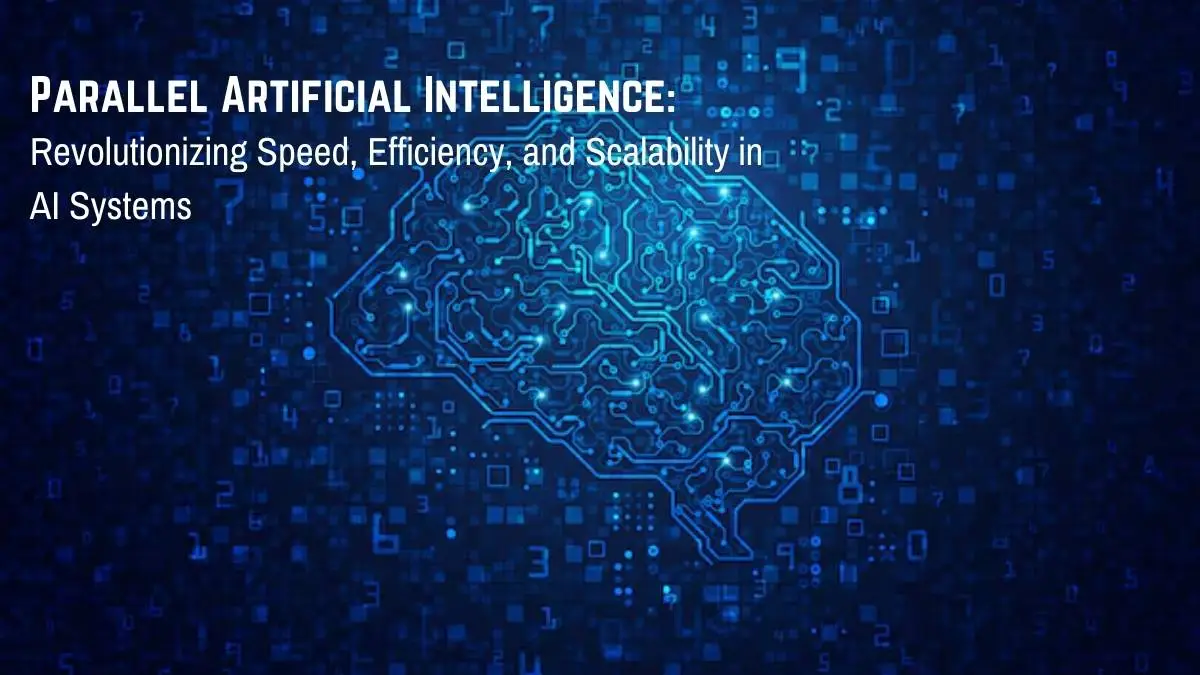
Artificial Intelligence is transforming the world. But as AI grows, so does the need for speed. Traditional AI struggles with large-scale computations. Enter Parallel Artificial Intelligence. This game-changer spreads complex tasks across multiple processors, slashing processing time. Think of it like a kitchen. One chef makes a meal slowly. A team? They finish fast. That’s Parallel AI—breaking tasks into smaller chunks, working together. Industries need it. Healthcare, finance, autonomous vehicles—everywhere speed matters. The demand for real-time AI solutions is rising. Parallel AI meets that demand. It’s the future of AI scalability and efficiency. And it’s happening now.
What is Parallel Artificial Intelligence?
Parallel Artificial Intelligence is AI steroids. Rather than processing step for step, it processes several operations at once. It’s a lot of brains working on one problem at a time. The old AI processed sequentially, taking one task at a time. But actual-world AI applications—autonomous cars, big data analysis—require quick responses. Parallel AI chops up tasks and spreads them among several computing units. This accelerates learning, improves efficiency, and enables AI to process gigantic datasets with ease. It’s a business revolutionizer, research booster, and AI engineer facilitator. As more AI is applied, Parallel AI is no longer a want—it’s a need.
The Evolution of Parallel AI
The history of Parallel Artificial Intelligence is intriguing. It began as a mere concept: why not employ multiple processors rather than one? Parallel computing was only a fantasy in the 1950s. Single-core systems were used for early AI models. Slow and inefficient. Then came multi-core processors. GPUs transformed AI training. Today, we have TPUs, cloud computing, and even quantum AI on the horizon. Each advance makes Parallel AI stronger. Firms such as Google and Nvidia are pushing the limits, making AI quicker than ever. The revolution is not yet complete. The next wave? AI supercomputing, where computers think at lightning speed.
How Parallel Computing Works in AI
Parallel computing is similar to teamwork. Rather than have one person do everything, several people do part of it. Parallel Artificial Intelligence is the same. It breaks difficult problems up into parts, which are solved at once. There are two big methods: data parallelism and task parallelism. Data parallelism breaks down large data sets into several processors, ideal for deep learning. Task parallelism distributes different tasks into different processors, ideal for workflow optimization. GPUs, TPUs, and cloud clusters drive these computations, which make AI models smarter, faster. The outcome? AI which learns fast, responds in real-time, and manages enormous workloads with ease.
Benefits of Parallel AI
Speed. Efficiency. Scalability. These are the pillars of Parallel Artificial Intelligence. Traditional AI models take weeks to train. Parallel AI slashes that time. It processes data in real-time, crucial for industries like finance and healthcare. Handling big data? No problem. Parallel AI scales effortlessly, managing massive datasets without bottlenecks. Real-time decision-making becomes seamless. Imagine self-driving cars reacting instantly or fraud detection systems catching threats before they happen. That’s Parallel AI in action. The world demands faster AI. Parallel AI delivers. It’s not just an upgrade—it’s a necessity for modern AI applications.
Applications of Parallel AI in Different Industries
Parallel Artificial Intelligence is everywhere. In healthcare, it analyzes medical images instantly, diagnosing diseases faster. In finance, it powers algorithmic trading, processing thousands of transactions per second. Autonomous vehicles? They rely on Parallel AI for real-time navigation. Even gaming benefits, with AI-driven NPC behavior adapting dynamically. Big data analytics, cybersecurity, robotics—the list goes on. Businesses adopting Parallel AI stay ahead, making smarter, faster decisions. Without it, industries lag. With it, they innovate. Every second counts in AI. Parallel AI ensures industries don’t just keep up—they lead.
Parallel AI in Deep Learning and Neural Networks
Deep learning thrives on Parallel Artificial Intelligence. Why? Because training neural networks is computationally heavy. Traditional AI models take days, sometimes weeks, to train. Parallel AI speeds up this process. It distributes computations across GPUs and TPUs, making learning faster and more efficient. Neural networks, with millions of parameters, require extensive processing power. Parallel AI handles it effortlessly. Cloud computing further boosts performance, allowing models to train on distributed servers worldwide. The result? Smarter AI, faster breakthroughs, and real-time learning. Parallel AI isn’t optional for deep learning—it’s the backbone.

Challenges and Limitations of Parallel AI
Nothing’s perfect. Parallel Artificial Intelligence faces hurdles. Hardware costs? High. Not every business can afford multi-GPU setups. Power consumption? Massive. Energy efficiency is a concern. Programming complexity? It’s tough. Parallelizing AI algorithms requires expertise. Synchronization issues? They happen. When multiple processors work together, timing matters. Latency can disrupt efficiency. Despite challenges, research continues. New frameworks, optimized hardware, and improved algorithms are making Parallel AI more accessible. The benefits far outweigh the drawbacks. But to maximize its potential, businesses must invest wisely, balancing power with cost-effectiveness.
Key Technologies Driving Parallel AI
Parallel Artificial Intelligence wouldn’t exist without cutting-edge tech. GPUs revolutionized AI. TPUs took it further, accelerating deep learning. Cloud computing enables distributed AI models, scaling globally. Edge AI brings Parallel AI to smart devices, reducing reliance on centralized servers. Quantum computing? It’s the next frontier, promising speeds beyond imagination. Companies like Google, Nvidia, and IBM drive these advancements, making AI more powerful. Without these technologies, Parallel AI wouldn’t thrive. As hardware evolves, Parallel AI will reach new heights, making real-time intelligence the norm, not the exception.
Future Trends in Parallel AI
What’s next for Parallel Artificial Intelligence? AI supercomputing. Imagine machines processing trillions of calculations in seconds. Quantum AI will push boundaries, making today’s AI seem slow. Automation will increase, reducing human intervention. Ethical AI will become a focus—fair, transparent, and unbiased. AI’s role in cybersecurity, space exploration, and climate modeling will expand. Governments and businesses will invest more, making Parallel AI mainstream. The AI race is accelerating. Those who adopt Parallel AI early? They’ll shape the future. The next decade will redefine intelligence as we know it.
How to Get Started with Parallel AI Development
Curious about Parallel Artificial Intelligence? Start with the right tools. TensorFlow and PyTorch support parallel processing. OpenMP and MPI optimize AI workflows. Programming languages like Python, CUDA, and Julia are essential. Want hands-on learning? Online courses from Coursera, Udacity, and edX offer deep insights. Experiment with cloud-based GPUs from AWS, Google Cloud, or Azure. Join AI forums, read research papers, stay updated. Parallel AI is complex but rewarding. Dive in, learn, and build the future. The AI revolution isn’t coming. It’s already here.
Conclusion
Parallel Artificial Intelligence isn’t just an innovation—it’s a necessity. AI is growing, and without parallel computing, it slows down. Industries rely on it for real-time insights, automation, and scalability. The future? Faster, smarter, more efficient AI. Companies adopting Parallel AI lead the race. Those who ignore it? They fall behind. As technology advances, Parallel AI will drive new possibilities. It’s shaping the next era of artificial intelligence. Ready or not, the AI revolution is here. The question is—are you part of it?
AI
RAGFlow: The Ultimate Tool for AI-Driven Workflow Automation
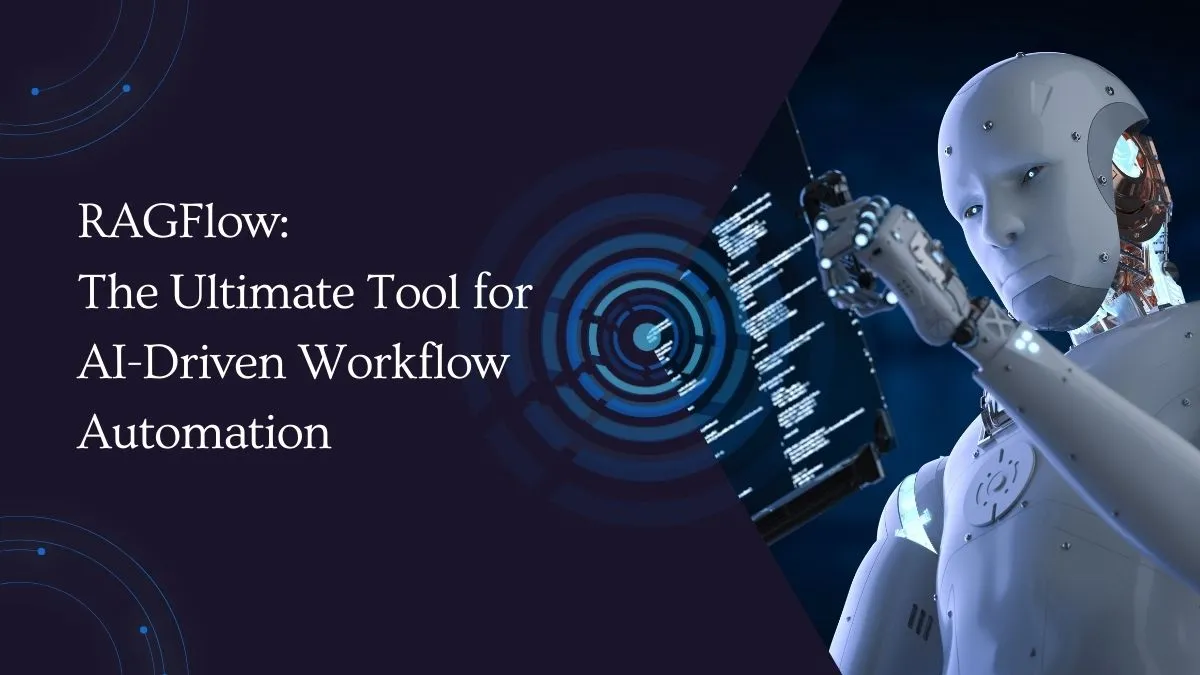
RAGFlow still remains a modern business platform that includes AI features in its functioning. Through the employment of the RAGFlow, and integrating Retrieval-Augmented Generation technology, business processes are optimized; work that would have otherwise needed to be done manually is automatic and intelligent solutions that offer enhanced decision-making is offered. It provides organizations with a golden chance to increase product, improve retrieval and processing of information as well as develop sophisticated solutions to what have hitherto been time-consuming manual chores. Automation is fast becoming as a necessity in the current generation competent business environment. Today, artificial intelligence (AI) is being used in most industries by different firms as a tool for making or improving on the existing business processes
Understanding Retrieval-Augmented Generation (RAG)
The essence of RAGFlow is the new generation Retrieval-Augmented Generation (RAG) engine that integrates the capabilities of both retrieval-based models and AI-generated content. Compared with the typical AI model that has only pre-specified data to answer questions, the RAG model obtains sufficient information from massive data and improves the outcomes by adding relevant information. By doing so it becomes far easier for RAGFlow to perform complicated tasks with far more accuracy and ability to adapt. Real-time data from multiple sources strengthens business productivity and it guarantees that workflow is effectively and efficiently improved with real-time data without compromising the data’s accuracy.
Core Features of RAGFlow
- Intelligent Data Retrieval: RAGFlow enables businesses to instantly access relevant data, improving decision-making speed and accuracy.
- Workflow Automation: The platform automates repetitive tasks like report generation, customer support, and data processing, increasing operational efficiency.
- AI-Driven Insights: It provides actionable insights through AI, enhancing data interpretation and facilitating smarter decision-making.
- Personalized Workflows: The platform allows businesses to tailor workflows based on customer preferences or historical data for improved user experiences.
- Scalability and Customization: It is highly scalable and adaptable, ensuring it can evolve with business growth and changing requirements.
How RAGFlow Integrates with Existing Systems
Another significant benefit associated with RAGFlow is actually the operational compatibility between the application and other business applications. Regardless of whether a business uses the Customer Relationship Management (CRM) tool, the Enterprise Resource Planning (ERP) software or any other system, They can easily integrated it with the help of the APIs or plugins available. The gradual adoption here makes it possible for organizations to maintain the current systems but add to them features of artificial intelligence driven automation and data acquisition. The fact that it can easily blend in various pre-existing IT systems is one of its key strengths for accountants because this means that companies can get the most, or even more, out of their investments in IT systems while using RAGFlow.
Workflow Automation
In terms of what RAGFlow stands to offer, the most important is the ability to automate the workflow. Organizations today are operating in the Global Village where time is investment, hence the need to minimize repetition or manual handling of activities that can efficiently be handled by automation. It has been quite successful in the ability of automating various ranges of workflows – simple as well as complex. For instance, it can perform roles such as data input, appointment setting and creation of reports that usually demand a lot of manual work. Furthermore, it has decision making capability wherein it can assign the customer service tickets; escalating tasks and make real time changes based on the defined business rule.

Enhancing Data Accessibility with RAGFlow
It is said that current business relies heavily on data but the data have to be collected, pulled and summarized in a timely and useful manner. This is done while utilizing real-time data processing and enhanced artificial intelligence, RAGFlow has been established as a solution that enhances data accessibility. All the historical sales data, customer feedback and performance data that help in decision making process are always on hand, accurate and updated at it. The result of this is that multiple team, or many departments across an organization are able to rely more on data to make decisions, more promptly. In addition, the opportunity to analyze and come up with the insight from the retrieved data leveraging it makes businesses ready to adapt to competitive forces in the market.
Improving Decision-Making through AI
The use of AI in business processes is to make better decisions based on data gathered throughout the different phases in the company. It stands out at this aspect given that RAGFlow now allows businesses to harness AI for its computation abilities to deliver knowledge out of intricate information sets commonly found in today’s enterprise financial transactions. It combines AI for generative text analysis with automated data collection-making it possible for companies to make decisions faster and better than it has ever been done. For example, it can process data on sales rates, comments, and situation and provide business tips within a few seconds that can contribute to more effective marketing decision making or enhance ways of interacting with the customer.

Cost-Effective Benefits
- Reduced Operational Costs: RAGFlow automates tasks like data entry, customer support, and report generation, cutting down on labor expenses.
- Increased Productivity: By automating routine processes, it enables employees to focus on higher-value tasks, boosting overall productivity.
- Minimized Human Error: It reduces the risk of costly mistakes caused by manual labor, improving accuracy and reliability.
- Efficient Resource Allocation: Automation with it allows businesses to allocate resources more effectively, optimizing capital usage.
- Enhanced ROI: By streamlining operations and cutting costs, it helps businesses achieve a higher return on investment.
AI-Powered Personalization Capabilities
Taking into account the buyer behavior, preferences and previous communications, RAGFlow adapts the offer of goods, services, and word and word-based actions to each buyer. This AI-associated personalization enhances client experience by ensuring that they are presented with current and appropriate information hence increasing client base and business continuity. Some use cases of it are Marketing automation where businesses can bring out customized marketing strategies, product recommendation where the business organizations can recommend products that the customer had purchased before and even advanced customer support where the business organizations can have tailored support to the customer questionnaires.
Conclusion
It was seen that RAGFlow is unique in its capacity to revolutionize the concept of using artificial intelligence in improving the business unit’s flowwork. Due to its high data retrieval mode as well as; flow capability; automation of work processes; provision of insights by an Artificial Intelligence system, it boosts productivity, keeps errors at bay, and provides a means of making better decisions. This aspect of the platform is efficient in driving down costs through the elimination of labor expenses, human mistake, and poor utilization of resources while creating greater ROI for companies at inception. Also, it is highly flexible and can easily be modified to meet the changing needs of your business so that it can be highly successful in the long run.
-

 BIOGRAPHY1 month ago
BIOGRAPHY1 month agoBehind the Scenes with Sandra Orlow: An Exclusive Interview
-

 HOME4 months ago
HOME4 months agoDiscovering Insights: A Deep Dive into the //vital-mag.net blog
-

 HOME7 months ago
HOME7 months agoSifangds in Action: Real-Life Applications and Success Stories
-

 BIOGRAPHY5 months ago
BIOGRAPHY5 months agoThe Woman Behind the Comedian: Meet Andrew Santino Wife

















